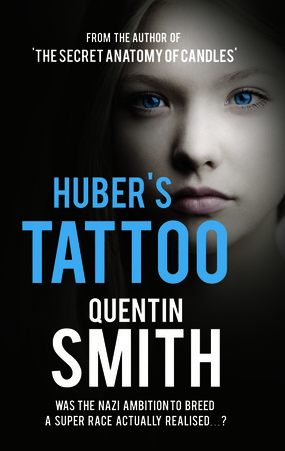
Huber's Tattoo (Matador 2014)
Imagine if the secretive Nazi ambition to breed a super intelligent race in the 1930s had been realised...
Huber's Tattoo reveals the complicity of the German medical and scientific establishments in the mechanics of engineering the Super Race.
Set in London in 2011, several loosely connected murders are gradually traced back to the secretive and shocking Nazi eugenics programme centred around Himmler’s Lebensborn birthing homes. As this bizarre pattern becomes more noticeable, the intellectually brilliant DCI Webber of Scotland Yard discovers, throughout the course of his investigation, that his own links to the Lebensborn programme, and the murders themselves, are much closer than he could have ever imagined. A parallel narrative, starting in Germany in 1936, follows the Nazi medical doctors involved in this ingenious secret project to engineer Aryan super intelligence. The two narratives eventually converge to create a thrilling finish.
“It is from the midst of this putrid sewer that the greatest river of human industry springs up. Here it is that humanity achieves for itself both perfection and brutalization.”
Huber’s Tattoo is the extraordinary story of a relatively unknown aspect of Nazi history. Viewed through contemporary characters who follow the clues back to the 1930s, the story suggests the impact such fiendish tampering with medicine and human development could have inflicted on future generations. Inspired by authors such as C.J. Sansom and Patricia Cornwell, Quentin is fascinated by the concept of engineering human intelligence, as well as the evil and misguided ambitions of the Nazi Lebensborn and eugenics programmes of the 1930’s. Huber’s Tattoo will appeal to fans of crime and historical fiction.
Imagine if the secretive Nazi ambition to breed a super intelligent race in the 1930s had been realised...
Huber's Tattoo reveals the complicity of the German medical and scientific establishments in the mechanics of engineering the Super Race.
Set in London in 2011, several loosely connected murders are gradually traced back to the secretive and shocking Nazi eugenics programme centred around Himmler’s Lebensborn birthing homes. As this bizarre pattern becomes more noticeable, the intellectually brilliant DCI Webber of Scotland Yard discovers, throughout the course of his investigation, that his own links to the Lebensborn programme, and the murders themselves, are much closer than he could have ever imagined. A parallel narrative, starting in Germany in 1936, follows the Nazi medical doctors involved in this ingenious secret project to engineer Aryan super intelligence. The two narratives eventually converge to create a thrilling finish.
“It is from the midst of this putrid sewer that the greatest river of human industry springs up. Here it is that humanity achieves for itself both perfection and brutalization.”
Huber’s Tattoo is the extraordinary story of a relatively unknown aspect of Nazi history. Viewed through contemporary characters who follow the clues back to the 1930s, the story suggests the impact such fiendish tampering with medicine and human development could have inflicted on future generations. Inspired by authors such as C.J. Sansom and Patricia Cornwell, Quentin is fascinated by the concept of engineering human intelligence, as well as the evil and misguided ambitions of the Nazi Lebensborn and eugenics programmes of the 1930’s. Huber’s Tattoo will appeal to fans of crime and historical fiction.
What inspired me to write Huber's Tattoo?
I am fascinated by the Second World War and many of the chilling projects that the Nazis conceived, far less well known than the extermination camps, but equally as horrifying. Mankind's zest for inhumanity seems endless at times. There are many untold stories from this extraordinary period in modern history and I have chosen one which fits in well with my medical knowledge and interest in the dark side of medicine as it might be practised in the margins of society.
To make it contemporary it is set in the present day as a racy crime thriller, constantly reaching back to the dark recesses of its historical origins.
I am fascinated by the Second World War and many of the chilling projects that the Nazis conceived, far less well known than the extermination camps, but equally as horrifying. Mankind's zest for inhumanity seems endless at times. There are many untold stories from this extraordinary period in modern history and I have chosen one which fits in well with my medical knowledge and interest in the dark side of medicine as it might be practised in the margins of society.
To make it contemporary it is set in the present day as a racy crime thriller, constantly reaching back to the dark recesses of its historical origins.
